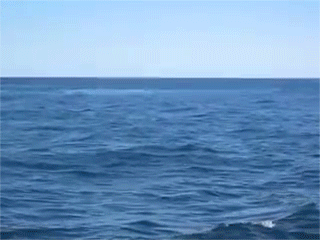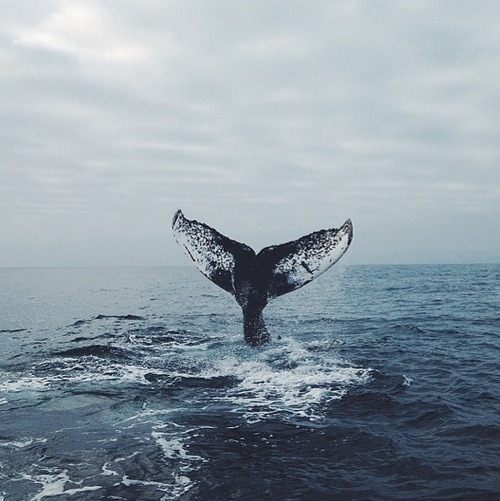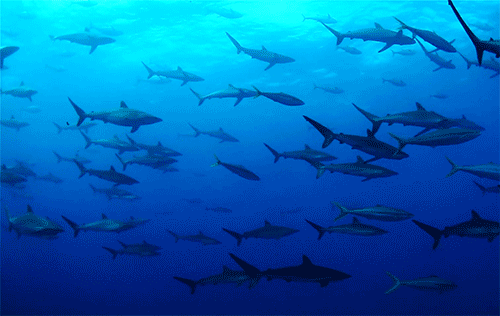A collection of videos, photos and articles from a divers perspective of the ocean. Feel free to share with friends and spread the word.
Don't wanna be here? Send us removal request.
Photo

2 Weeks in Europe armed with a @Opekta Fisheye. London’s architecture was a great way to start.
0 notes
Text
Sleeping Humpback Whale Encounter
This January I travelled to Salt Cay, Turks and Caicos, a small caribbean island with a fluctuating population of 50-100 as people come and go mainly to avoid the hurricane season. The island itself has a rich history and was once the economically centre of the Turks and Caicos and the largest exporter of salt throughout the British West Indies. There are many reminders of this era, from the redundant salt ponds, the now wild donkey population (donkeys were brought to the island to work on the salt ponds, pulling carts of salt to be loaded and exported) and the magnificent white house.Flights from Providenciales and Grand Turk operate a few days a week in a small 8 passenger plane and I arrived in the afternoon having travelled to “Provo” via Charlotte, North Carolina.
Salt Cay doesn’t boast as big of a tourism industry as the bigger more popular islands throughout the Turks and Caicos however it is very popular for one thing in particular. Humpback Whales.
Every year between January and April the migrating population of the Atlantic Humpback whales travel past Salt Cay over the shallow banks. Salt Cay is situated in-between the Columbus Passage, an extremely deep passage that in some areas can reach 3,000ft, and the shallow banks that stretch out to the beginning of the Atlantic ocean. Humpback whales are often seen in these shallow banks with mothers favouring this as a nursery ground for their newly born calves.
Myself and two other researchers, weather permitting, would head out on a daily basis to search for whales and collect data; on their location, group size and behaviour - we would also attempt to photograph the whales in an effort to ID individuals that had been spotted in previous years. Over time we identified hotspots and would often return to find the same whales hanging around their last noted location. An area that gave us great success throughout the season was the surrounding waters of Great Sand Cay, an uninhabited island 7 nautical miles south of Salt Cay and nearly as far from civilisation as you can get in the Turks and Caicos.
Great Sand Cay is on of the most beautiful islands I have ever laid my eyes on, a hidden paradise with long golden beaches and white cliffs. The surrounding waters begin to level out at around 25-35ft (8-12m) and are protected from the Atlantic swells. It was in this area that we encountered the majority of our most spectacular interactions with the Humpbacks. Whales often exhibited different behaviour in these waters and it was concluded that this area promoted a more relaxed encounter with the Humpbacks.
Mothers were able to rest in these areas allowing their inquisitive calves the opportunity to explore the surrounding waters without wandering to far from their mother’s protection. The crystal clear water made our job easy with finding the whales and whilst waiting for them to surface we sometimes could even make out their silhouettes through the water.
The protocol that we followed stated that we had to stop operating the boat when around 100m from the whales and if we deemed it right at 100m we would try to visual observe the whales from in the water. Entering the water without splashing was important to make sure the whales weren’t spooked as well as swimming without slapping your fins or splashing. With one or more of us staying on the boat to act as a guide directing us towards the Humpbacks.
In February, our most successful month, we were conducting our normal search for whales. The conditions were great with calm seas, little wind and the sun was high in the sky giving us great light. We would often spot the blows first or the dorsal fin of the whale. Looking into the sun we noticed that there was light bouncing off something at the surface, a potential whale, but it was not a shape we had noticed before. We were still around 600m away from whatever it was and began to approach with the engine in idle. As we began to get closer the shape became clearer to us and appeared to be a fluke, however the side that on show was mostly white and completely static. The majority of Atlantic Humpbacks have darker skin pigmentation than other populations and we had never observed a white fluke before, we began to get within 200m of the whale and were approaching on the windward side, with the engine in idle using the current to drift us closer and closer.
The whale hadn’t moved once since we had initially spotted it and it was a behaviour that we had never witnessed before. We had witnessed sleeping/resting whales before but they were always fully submerged, nobody said anything at the time but later that day we all admitted to being a little worried that we were going to witness an injured or even dead whale.
We got within range of attempting an in water encounter, we donned fins and masks and entered the water even more quieter than usual. The water was crystal clear but we still needed directing by Francios, a French marine biologist in our team, and we slowly approached the whale. The shadow is the first thing that emerges out of the blue as you swim towards a whale, then you notice the strong white piercing the blue of their long pectoral fins. The full body became clear and we laid eyes on a fully healthy, sleeping Humpback.
https://www.youtube.com/watch?v=jOamfKwr6aU
The Humpback was sound asleep, vertically hoisted in the water with the fluke out of the water and having been confused before about the colour we now realised that it was the underside on show. With the whale being so relaxed the fluke had fully flopped over and was acting as a sort of stabiliser at the surface. The whale was completely at peace in the water and remaining silent we floated and observed getting a great look at the giant.
We had been floating for around 10 minutes when the whale made it’s first movement. Humpbacks just as dolphins and the majority of other whales sleep by resting half of their brain, the other half remains alert remembering to breath and being aware of danger in the area. Whales have to make a conscious effort to breath unlike human where most of the time we breath without realising.
The whale was coming up to breath, with a slight movement of the fluke and twisting her body using the pectoral fins she brought her head up right close to us as if to get a look at it. I froze exactly where I was, I had never been approached by a whale before, only observed them as they swam by, it was as if she was checking us out. Slowly passing us in a trance like state she took several breaths and continued to sleep around 50m away, the encounter lasted in total for around 20mins and it was an experience we would all never forget. After the whale had initially checked us out I swam back to the boat to allow Francios the opportunity to observe this rare interaction.
She continued to rest and upon surfacing again checked the other researchers out before returning to sleep, we left her after this. I know I referred to the whale as her and I have no idea of the whale’s gender, but with the little amount of scars on it’s body and the look of her face (Despite sporting a little beard of algae growth just under her chin) I imagined that she is a female, still young and making the migration for her first or second time. Although none of this can be confirmed I prefer her as apposed to it, the whale is not an object it is a highly conscious being that we have yet come to fully understand and if you are a dude I’m sorry Mr Whale.
I managed to record the entire encounter on my GoPro and it is available to see on my vimeo account(www.vimeo.com/pangamx). This was the first encounter we had with this behaviour witness but it wasn’t the last, we witnessed another whale in exactly the same state and another sail boat in the area presented us with a diagram they drew after witnessing this behaviour in the vicinity of Great Sand Cay.
By Kieran Bown
#whale#humpback whale#marine research#Ocean Research#turks and caicos islands#adventure#scuba adventure#travel#scuba#diving#scuab diving#gopro
0 notes
Text
The USS Ortolan ASR-5 and it’s Raising of the Japanese Midget Submarine HA-8
Introduction
For most when thinking about world war two the idea of any diving taking place doesn’t really occur, but by 1945 over 320,000 men had been involved in dives throughout all corners of the warzone. From assisting with training exercises with submarines to recovering wrecked military equipment divers were an important part of the advance throughout the South Pacific, European and African fronts.
Looking at one particular mission in particular the raising of the Japanese Midget Submarine HA-8, here is the story of how the divers and their vessel USS Ortolan ASR-5 (Submarine Rescue Ship) came to be in the Solomon Islands in 1943 and how the divers completed the task of raising the enemy vessel.

Source
The Origin of the Ortolan
Originally constructed in 1918 and launched a year later the primary role of the USS Ortolan AM-45 was to be a minesweeper. She was constructed in New York and then transported via the Panama Canal to the Pacific Coast where she worked between California and Washington harbours.
Her main duties were to assist with Submarine Divisions throughout the 1920s and it wasn’t until 1929 that her designation was changed from AM to ASR (Minesweeper to Submarine Rescue Ship/Vessel)
Although her missions were now different she continued to operate in the same area working out of California which also included a brief four month spell in Pearl Harbour during 1936.
Introduction to the War
The Ortolan started her world war two action on 21st December 1941 when she arrived at Pearl Harbour following the attack from the Imperial Navy. The USS Ortolan ASR-5 began a 6 month salvage mission, eventually raising the USS Oglala a minesweeper that would be returned to the Pacific Coast to complete further refurbishment before returning to active duty.
After this initial salvage operation the USS Ortolan ASR-5 was assigned at Pearl Harbour to assist with the tactically training of Submarines. Her main duties were to recover practice torpedoes and mines as well as assisting with the training and readying of the submarines for their war patrols in the South Pacific. This lasted for little under 6 months whilst she made her final preparations for the voyage to Australia where she would join the fight.
South Pacific Duties
The Ortolan’s first involvement in the South Pacific was in Vanuatu, the USS Coolidge had recently sunk just outside of Espiritu Santo after hitting friendly mines and sunk full of vitally needed war supplies. The Ortolan’s divers spent 10 days recovering what they could before heading further north to Tugali in the Solomon Islands.
She initially provided repair of damaged cruisers following the Battle of Tassafaronga and 12 days later the cruisers left heading further north. At this point the Ortolan stayed put assisting with submarine patrols and it was at this point that the Ortolan encountered the HA-8 Midget Submarine.
Midget Submarines
Midget submarines were a tactic employed by the Imperial Navy throughout world war two and up until the attack on Pearl Harbour were in fact a secret weapon never seen before. The Midget Submarines branded “The Coffin Boats” in 1986 by Peggy Warner and Sadao Seno were two man operated small attack submarines that were towed by larger vessels or submarines close to targets where they were released. It was a given that the “Coffin Boat” operators would never be seen again, very similar to Japan’s other kamikaze style operations. Armed with only two torpedoes the Midget Submarines were briefed with their target and released to hunt. They were also equipped with a self-destruct explosives should their mission become compromised they were to destroy themselves and the submarine to prevent themselves from being captured alive and any sensitive information onboard fall in to the wrong hands.
The Japanese that died inside the Midget Submarines were branded as war gods back in Tokyo and in 1942 after Australia returned the cremated ashes of two Midget Submarine operators there was hung celebration of the triumph and honour they had bestowed on their nation and family.
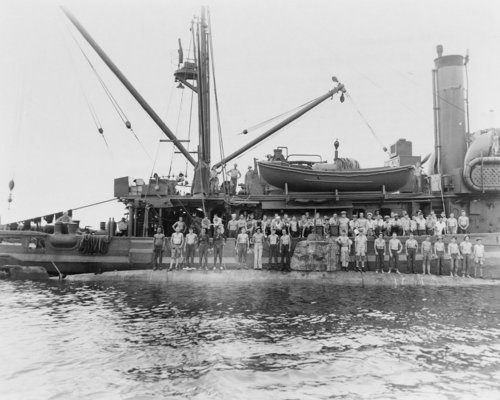
Source
Raising the HA-8
Upon locating the HA-8 in June 1943 just off the coast of Guadacanal, Solomon Islands the USS Ortolans set about surfacing the Midget Submarine. Midget Submarines often carried highly needed intelligence and divers J.W. Crawford, Douglas R. Kemp and Lt. F. X. Sommer (M.C.) USNR descended onto the wrecked submarine.
Once the divers had released the submarines batteries it became neutrally buoyant and floated to the surface. Upon searching the inside of the submarine both of the Japanese operators bodies were found as well as Japanese documents that were assessed by the Captain and Officers onboard the Ortolan.
https://www.youtube.com/watch?v=trt54pyBXF4
Rare footage captures the surfacing of the HA-8 and shows some of the divers working as it is brought up alongside the USS Ortolan ASR-5. The HA-8 was then towed to Kukum Bay and was eventually transferred to the United States.
https://www.youtube.com/watch?v=pXKUeprSCa0
It is now one of only 4 Midget Submarines available for viewing as it is kept at the Historic Ship Nautilus & Submarine Force Museum.
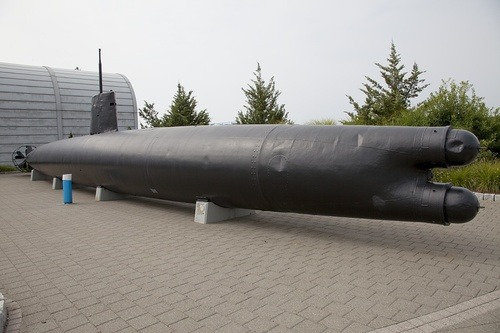
Source
By Kieran Bown
#world war 2#navy diver#imperial navy#midget submarine#national geographic#Discovery Channel#History#history channel
0 notes
Photo
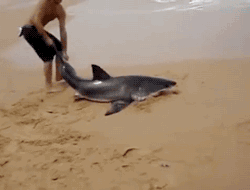

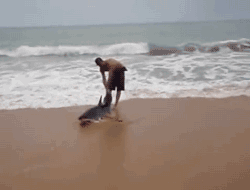

Saving dauphins is expected, but this guy saves a shark!!! Thank you sir, for showing us there’s still some hope for humanity!
more amazing people«
165K notes
·
View notes
Photo

I really wanted to work on some personal projects over the mid semester break, but just ended up being way too busy just catching up on other things. A week is nothing, especially with assignments and an elective during the week, anyway. So I decided to redo this poster (original) so I feel like I’ve accomplished something, and put the other stuff off until the summer break, which is only 46 days away(!!).
959 notes
·
View notes
Link
This incredible footage of a Shark on shark attack was captured during my diving at Neptune Islands, South Australia. This video shows unbelievably rare beha...
1 note
·
View note
Quote
“No aquarium, no tank in a marine land, however spacious it may be, can begin to duplicate the conditions of the sea. And no dolphin who inhabits one of those aquariums or one of those marine lands can be considered normal.”
Jacques Yves Cousteau
4 notes
·
View notes
Text
SS Presidential Coolidge
SS Presidential Coolidge
The story of how a once luxury liner transformed to support Allied forces throughout the second world war and eventually came to rest to create one of the best wreck dives in the world. Accessible to both recreational and technical divers it offers the opportunity to travel back in time and experience the hidden secrets of the SS Presidential Coolidge as they are preserved beneath the waters of the beautiful South Pacific.

Source
Pre-War
Originally constructed by the Newport News Shipbuilding and Drydock company in Virginia - following an order from Dollar Lines for two luxury liners capable of transporting holiday makers across the Pacific to Asia. It took two years for both to be constructed and upon completion in 1931 they were the largest merchant ships ever to be constructed in the USA at that time. Capable of carrying just under a 1,000 passengers.

Source
Their homeport of San Francisco saw the majority of their voyages across the Pacific bringing holiday makers back and forth from Asia to the Pacific coast of the United States. 1st class passengers onboard were able to enjoy such luxuries as spacious staterooms and lounges as well as private telephones and salt water swimming pools.
The Coolidge’s sister ship the SS Presidential Hoover ran aground in 1937 and was declared a loss and a year later the Coolidge was arrested as Dollar Lines were in a huge debt of $35,000 (Estimated to an equivalent of $6,000,000 in todays market) and later begun service again a year later under the newly formed American President Lines until the start of the second world war.

Source
World War Two Involvement
Although the Coolidge was not equipped with any guns or military equipment she was first involved in the WW2 in 1940. As relationships between Japan and Great Britain deteriorated she was first employed to help evacuate US Citizens from Hong Kong back to the United States.
Following this Coolidge took part in several more evacuations throughout Asia as the Japanese became ever more aggressive with their neighbouring countries. Throughout 1941 she was used a troopship for the US Navy reinforcing the Pacific frontier in await of the imminent attack from Japan.
7th December 1941 brought the Imperial Navy’s attack on Pearl Harbour and 12 days later the Coolidge arrived to evacuate 125 critical injured naval patients tended for by 5 medical staff recently evacuated from the Philippines. The Pacific became an ever growing war zone as hostility had now reached as far as Hawaii.
The following month the Coolidge was returning to the Pacific frontier via Australia transporting troops , ammunition, weapons and P-10 Fighters. These supplies would be transported further north to Java and Indonesia to reinforce the frontline against Japanese forces. All of these duties were completed in her pre-war condition and it was only after this operation that modifications began converting the luxury cabins and lounges changing the current capacity of 988 to over 5,000. Guns were mounted, she was painted haze grey and was officially assigned to the US Navy by the War Shipping Administration.
She continued to serve as a troop and transport ship completing voyages throughout the South Pacific to New Zealand, Australia, Fiji, Bora Bora and Vanuatu.
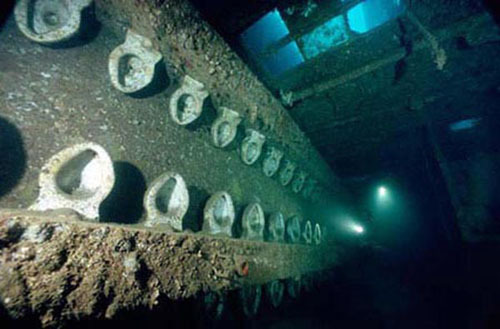
Source
Loss of the Coolidge

Source
It was in Vanuatu that the Coolidge was lost. One of Vanuatu’s largest islands, Espirutu Santo had been established as one of the strongholds of the US forces, containing an airfield, military base and a heavily protected harbour. The surrounding channels and ports of entry to Espirutu Santo had been laid with mines to protect against a water based assault or Japanese submarines in search of a target.
For reasons unknown the Coolidge hadn’t received information on the safe passage into the harbour and for fear of attack from Japanese submarines Captain Nelson chose to enter the harbour through the largest channel. The Coolidge hit two mines on her approach, Captain Nelson feared losing his ship and he made the decision to ground the ship on a nearby reef ordering all 5,340 men to abandon ship leaving all belongings behind.
Over a period of 90mins all passengers onboard made their way to lifeboats and made it to sure without panic and in quite a relaxed fashion. Most believed that salvage missions would take place over the next few days so their was no hurry to remove any of the Coolidge’s cargo.
Only two men were lost; Fireman Robert Reid was the first to be killed after the Coolidge made contact with the first mine and it exploded killing him instantly. Captain Elwood Joseph Euart had safely made it off the Coolidge only to hear that there were men still trapped in the infirmary. Euart returned and successfully helped all of the trapped men escape only to become trapped himself and unable to escape. A memorial was placed for Captain Elwood Joseph Euart on a nearby shore following his heroic actions.
The Coolidge, still heavy from her cargo sank quicker than expected and slid down the slope into the channel. She now rests on her port side with her bow at a depth of 21m (70ft) and her stern at 73m (240ft).
Salvage
USS Ortolan ASR-5 arrived following the sinking of the Coolidge and began a 10 day salvage operation to recover much needed war supplies such as brass casing of shells, ammunition and weapons.
The Ortolan ASR-5 then continued north continuing on her salvaging and repair missions. Helping even with military intelligence when she raised two sunken Japanese Submarines.
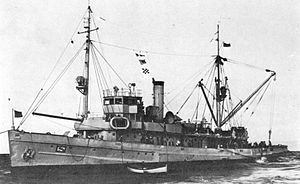
Source
Declaration of Protected Wreck and Dive Site
When Vanuatu became independent of France and Great Britain in 1980 the local government declared that the site of the Coolidge become a protected wreck and dive site and no further artefacts were to be removed.
Since the passing of the protected site the wreck has been an ever-growing hit with both recreational and technical divers. For those lucky enough to get in the water on this site they have the opportunity to see guns, cannons, Jeeps, helmets, trucks and personal supplies. Although for most the main attraction is “The Lady” a porcelain relief of a lady riding a unicorn which is still in good condition inside of the 1st Class smokers lounge.
The Coolidge now also provides a home for marine life with divers often seeing moray eels, sea turtles, lion fish, barracuda and the occasional reef shark.
With depths of the wreck starting at 20m it allows divers without technical experience or qualifications to explore the wreck easily and witness the lost supplies of the US advance.
In 2007 the Coolidge was rated in the “Top 10 wreck dives” by the British Newspaper The Times.
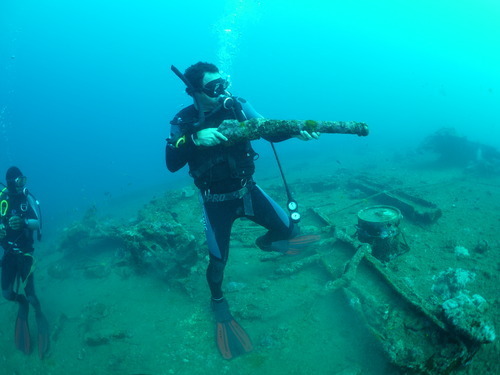
Source
By Kieran Bown
#scuba#shipwreck#Scuba Adventure#travel#dive travel#scuba travel#scuba trip#world war 2#History#national geographic#Discovery Channel
0 notes
Text
USS Saratoga - Aircraft Carrier Shipwreck
USS Saratoga
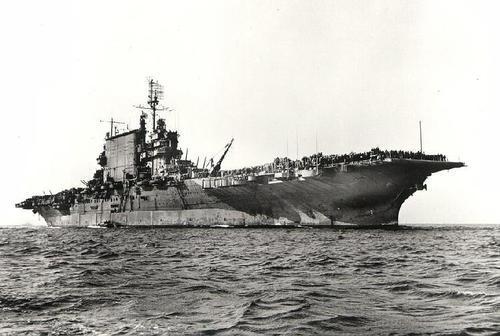
Source
Although this wreck was not sunk during a battle it is still one of the best shipwrecks in the world. She sustained direct hits from torpedoes on more than one occasion from Japanese forces and after undergoing repair made it back to assist with the South Pacific assault throughout the Allied forces advance towards Japan.
She was modified from battleship to carrier in the 1920s it was one of the first aircraft carriers of the United States Navy and was one of only three aircraft carriers to be built prior to the start of WW2. Prior to the war it was mainly used for training and development of carrier based tactics in a series of annual exercises. These often included surprise attacks of which some were successfully completed at Pearl Harbour.
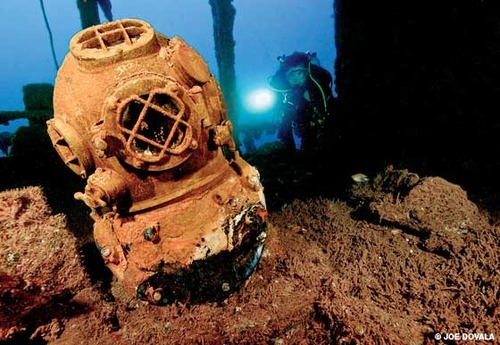
Source
Shortly after the Japanese attack on Pearl Harbour and the capture of Wake Island, the Saratoga was the centrepiece of a failed attempt to recapture Wake Island from the Imperial Navy. Where she was torpedoed for the first time, at this point she under went repair and it wasn’t until one year later that she returned to active duty.
After sinking the Ryūjō a smaller Japanese aircraft carrier during the Battle of the Eastern Solomon Islands, she continued with the ongoing campaign and received another hit from Japanese torpedoes. At this point she returned to the Solomon Islands to be repaired.
Throughout the rest of the second world war she continued to assist with US Navy and Royal Navy operations and managed to survive the rest of the war.
At the time of the surrender of the Japanese the Saratoga was now one of the oldest aircraft carriers in use by the US Navy and it was decided that she were to be used in a series of Nuclear Bomb tests upon ships in Bikini Atoll, Marshall Islands.
In mid 1946 she received her first direct hit from a nuclear bomb which she survived and was sunken by the second which exploded some 400m away from the ship. She now sits with her highest point at 15m (100ft) below the surface. She is one of only 3 aircraft carrier wrecks in the world making her a spectacular dive.

Source
The surrounding area also hosts some of the Saratoga's aircraft as well as some other wrecks that were also sunk during the nuclear bomb tests of Operation Crossroads. With other articles of interest being located at a lot deeper than 100ft makes this location a huge hit with technical divers.
By Kieran Bown
#dive#dive travel#Discovery Channel#national geographic#shipwreck#world war 2#ww2 history#ww2#Scuba Adventure#scuba#scuba diving#scuba travel#scuba trip#History#marshall islands#bikini atoll
1 note
·
View note
Text
WA Shark Cull comes to an end....
The Shark Cull
Early this year we posted two articles surrounding the misrepresentation of sharks in the mainstream media, whether it being on the News or Shark Week stories on the discovery channel. As well as the repercussions of installing fear and unrest for human safety when near or in shark “infested” waters.
As a result of a small number of recorded shark attacks over previous years, the Western Australian Government trialled a shark cull program earlier this year with the intention of deterring great white sharks from popular beaches and improving the safety of beach goers and surfers.
The Government outlined that only sharks over 3m are to be “humanely destroy” which often included sharks being hooked for several hours to a baited drum in distress until fisherman arrived to shoot it with a rifle before dumping the remains back to the ocean.
Great White Sharks were accredited with the most recent shark attacks and it was these attacks that spawned the shark cull. Despite Great White Sharks being an endangered species, protected by both Federal and Commonwealth Law in WA waters, measures were taken to kill an estimated 25 during the 13 week cull.
Within 24hrs of the Shark Cull being introduced fisheries stated that a Bull Shark had been successful caught and killed. However Hugh Edwards an Australian journalist and marine photographer stated that the shark was in fact a Tiger Shark. Suggesting that the commercial fisherman are killing sharks without successfully identifying the species.

Source
Both Colin Barnett (WA Premier) and Ken Baston (WA Fisheries Minister) responded to the comments made by Edwards. Explaining that all the fisherman identify the caught sharks by “onboard documentation” but would not clarify what this documentation was, leading to speculation that fisherman do not have any identification techniques and have limited knowledge on the issue.
In response Baston stated that even though the initial identification was incorrect it didn’t matter as Tiger Sharks were also on the list of intended targets. Whereas Barnett failed to budge and stuck with the fisherman "We're talking about a commercial, experienced fisherman. I would trust the fisherman to identify the shark."
Over the Shark Cull trial not a single Great White Shark was caught or killed with the majority of sharks killed being larger Tiger and Bull Sharks. 172 Sharks were caught on the drum lines of which nearly a 100 were killed of which just over 50% met specifications of the intended sharks to be killed.
Government officials proposed the Shark Cull be trialled for a further 3 years stating that the data collected from this initial trial is not substantial to determine whether or not the Shark Cull produced results, making beach goers, surfers and divers safer.
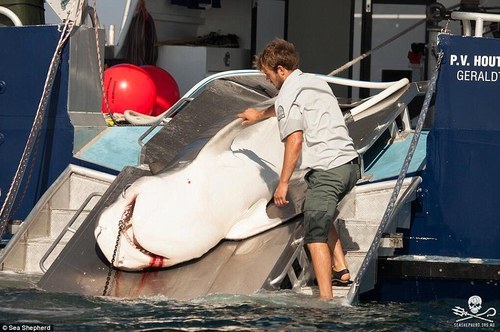
Source
WA Public demands end to Cull
With a staggering number of the general public apposing the cull it was only a matter a of time until the WA Governments program be shut down. Petitions signed by over 30,000, statements made by the EPA (Environmental Protection Authority), public protests and other conservation groups stepping forward led to a decision being made in September that the cull be banned and any attempts at installing the drums for the upcoming Australian summer be banned.

Source
Colin Barnett has until October to appeal but it already has been suggested that he will not submit and appeal. Although that hasn’t stopped him from making statements expressing his disappointment at the decision.
“I cannot look the people in the south-west in the face and say ‘your beaches are safe, your diving [and] surfing conditions are safe’ because I don’t believe they are.”
Barnett has been in the spotlight ever since introducing the shark cull, after receiving a number of death threats he increased the overall cost of the shark cull by hiring extra security to keep him safe.
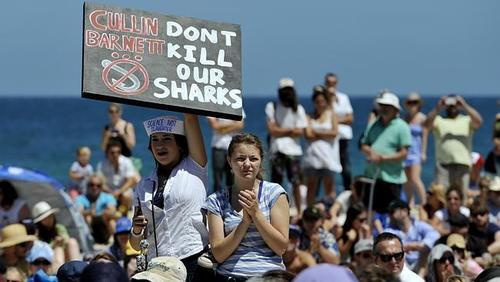
Source
Supressed information finally makes it out
It doesn’t take rocket science to understand what attracts sharks. If fisherman are shooting sharks and returning their bleeding remains into the ocean this is only going to lead to one thing. MORE SHARKS!
Sharks will come and investigate the scene and as more and more sharks are caught this will only result in more sharks being in the area. This vicious circle is only going to result in a number of things a growing number of sharks being killed as well as a bigger population of sharks in an area specifically identified as a popular spot for the public.
Ross Weir of the WASC (Western Australian Shark Conservation) recently spoke with Paul Murray of RADIO 6PR revealing information previously unknown about the Shark Cull and how the WA Government tried to suppress information showing the general public disgust at the cull.
Another interview with a Sea Shepherd representative stated that once sharks under 3m have been tagged and released they are often left in a state of shock known as Tonic Immobility which often results in them struggling to swim/breath and them sinking to the bottom of the ocean to their death.
Overall the Shark Cull has been unable to produce any positive results and has rightfully been put to an end.
By Kieran Bown
Panga MX
4 notes
·
View notes
Link
Whilst working in Turks & Caicos from January to April 2014 we had some awesome encounters with marine life, here is just a small taster of some of the stuff we…
#whales#whale research#humpback whale#marine biology#turks and caicos islands#diving#Scuba Adventure#scuba diving#travel
1 note
·
View note
Text
Ocean Sampling Day
Ocean Sampling Day
June 21st 2014 will be a special day for all ocean lovers out there. It is the first time that researchers all around the world join forces to make a population count of the microorganisms of the ocean. Marine microbe consists of a variety of algae, bacteria, archaea, protozoa, fungi and viruses. Some people may not appreciate this fact; but in one single drop of seawater you can find up to a Million bacteria. Besides the broad belief the most bacteria are not harmful for us, we even depend on them and their activity. They are very important in recycling debris to make it useful for other organisms. They are also responsible for the production of 50% of the oxygen we need to breathe.
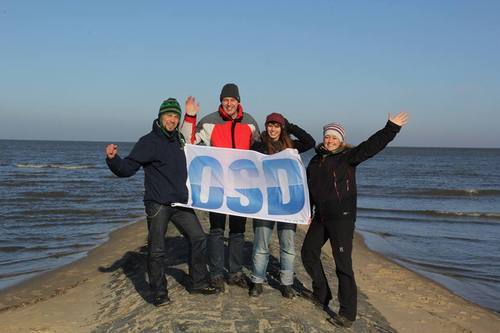
There have been several studies of marine microorganism before e.g. the Global Ocean Sampling (GOS) Expedition by Craig Venter, but the Ocean Sampling Day (OSD), organized by the EU funded Micro B3 Project, is a unique event. For the first time we have the chance to look at the marine microbial community and their actions on one single day. Over 160 research teams all over the world join together to create the biggest marine microbial dataset ever taken on one day. But not only scientists can join -Everyone who is interested can help by collecting important environmental parameters! On June 21st you can go out to the coast or ocean and take a water sample measuring e.g. temperature or salinity and much more. Collect all this data via our OSD Smartphone App or enter it online. Find out more on our webpage www.my-osd.org.

How to study the microbes
As the name already implies, microbes are very small organisms around 0.5-5 micrometers in size, so you cannot see them with bare eyes. Even under the microscope it is very hard to see and distinguish them. Therefore, we use a different way to figure out who is out there: We use their DNA. All bacteria and archaea have a gene called 16S rRNA which is always a bit different in each species.From these differences in their DNA sequences, we can find out which bacteria are in the water. To get an idea of what these microbes are doing, we sequence all the DNA from a water sample and see what other genes we can find in there. These genes give us ideas about the metabolic and anabolic pathways they use and how they are influencing their environment. We also hope to find some new genes which might be interesting for biotechnological approaches.
So join us in this historic event and go out sampling on June 21st, Saturday! Please also help us to spread the word by using the hashtag #osd2014

Citizen Science webpage:
www.my-osd.org
Video tutorial:
https://www.youtube.com/watch?v=1lhDdPbzuTs
Project webpage:
www.oceansamplingday.org
NOAA provided very nice info material you can find it here
http://oceanexplorer.noaa.gov/ocean-sampling-day/welcome.html
2 notes
·
View notes
Link
Rescuing a baby humpback that was tangled in cray pot lines off Geraldton, Western Australia.
0 notes
Text
Top 10 Deep Sea Monsters
1.Goblin Shark

Source
A prehistoric Shark that’s lineage goes back some 125 million years they live somewhere between 100m-1000m+ and scientists have very little known about their lives but the most recorded catches or interactions have been spread out across the Atlantic from the Gulf of Mexico to the Brazilian Coast.
2. Fang Tooth Fish

Source
At 18cm long once fully grown the Fang Tooth Fish is hardly anything menacing like a shark but its definitely one of the funniest looking in the Top 10 Sea Monsters. They live at depths between 200m to 2,000m but have been found at depths up to 5,000m. They feed primarily on zooplankton and once matured can hunt larger fish and squid.
3. Chimaera

Source
A close relative to the shark in that their lineage branches back 400 million years, their bones are made of cartilage and males posses claspers to fertilise females. Once in abundance as fossils have been discovered of them in mass, they now are rarely seen and have descended to live at depths 400m to 4,000m.
4. Prickly Shark

Source
Juvenile pictured although these sharks cane each up to 4m and live in depths between 100m to 650m they often are seen in shallow waters at night after sleeping through the day to hunt. Its appearance different to other sharks with two large dorsal fins and its skin consisting of row upon row of small spikes.
5. Giant Isopod

Source
Related to the common woodlouse, Giant Isopods live at depth and are rarely seen together unless at a food source, they are not commercially fished and are usually catch as a by catch by shrimp fisherman. Despite the small size of their relatives Giant Isopods can grow up to the size of a domestic cat 18cm to 36cm in length.
6. Blobfish
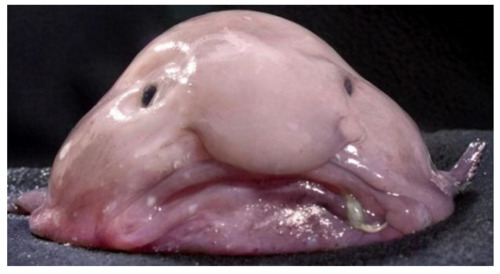
Source
Living in the waters surrounding Australia, Tasmania and New Zealand at around 600m to 1,200m the Blobfish is one of the strangest fish to be on the Top 10 Sea Monsters. The Blobfish floats around not to far from the bottom eating floating matter.
7. Skate Fish

Source
The Skate fish lives at great depths and have been around for some 150 million years. They are subject to over fishing, although their are data insufficient to put any idea of a population together, they are listed on Greenpeace Red list (A list of seafood sold in supermarkets that are endangered)
8. Angler Fish

Source
Living at depths somewhere between 1,500m to 2,500m where food is rare, Angler Fish have developed an extra fin that with the help of bioluminescence works as a lure to other smaller fish that make up food for the larger female angler fish.
9. Phronima

Source
Living at extreme depths around the world the Phronima is semi-transparent and is commonly referred to as a parasite. However how the Phronima feeds and breads, it's attaches itself to salps (Plankton) and then eats out the inner part leaving the gelatinous shell. Once the shell is empty females fill it with their eggs and push it into the current, moving through the water algae will develop to provide food for the eggs.
10. Yeti Crab

Source
The Yeti Crab lives at over 3,000m making it one of the deepest ocean occupiers on this list and inhabits the South Pacific oceans. Mainly known to feed on algae and shrimp.
#crab#deep sea#deep blue#ocean#monster#creatures#scary creatures#national geographic#bbc#Discovery Channel#angler fish#shark#dive#scuba#adventure#travel
26 notes
·
View notes
